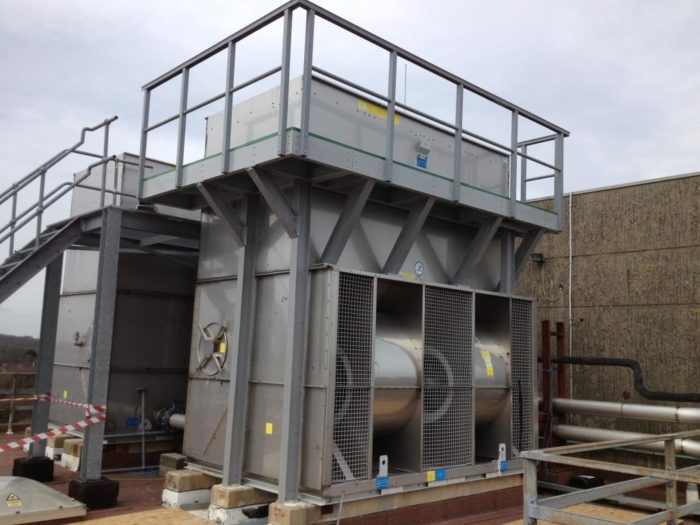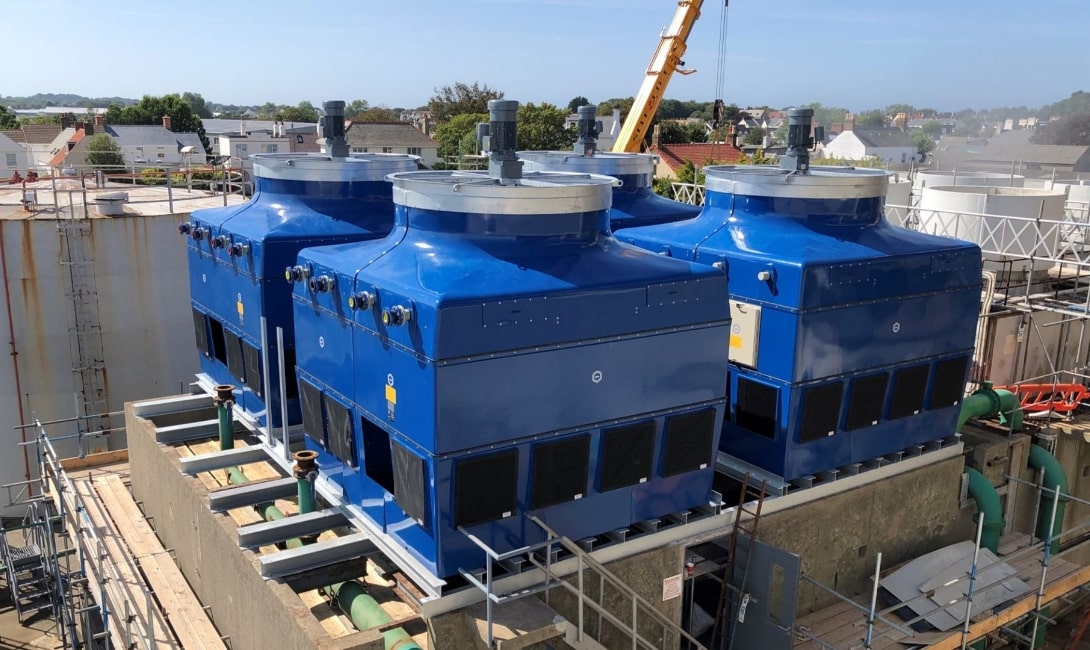GRP vs Steel & Why the Casing Material Matters
The grudge match is on…who will conquer…will it be the gleaming shiny heavyweight stainless casing of the steel variety, or will it be the lightweight, smooth gel-coated, Glass Reinforced Plastic (GRP) cooling tower? Both have their strengths and weaknesses and put them in different environments and the tables can turn quickly. Buckle up for what promises to be ultimate game of Top Trumps as we seek to determine the ultimate cooling tower casing material to serve your cooling needs!!
It’s no secret that Vistech are big fans of GRP cooling towers and through our partnership with EWK we have installed over 275 towers within the UK since 2003. It is important to note however, that there are instances when GRP may not be suitable and understanding the different types of casing material available, will assist you, our clients, in reaching an informed decision when selecting a new cooling tower.
Through the refurbishment arm of our business, we also have decades of experience in maintaining and refurbishing (including full replacement) of steel towers so are well positioned to provide insight into the pros and cons of each material.


A Brief History of Cooling Tower Construction
Timber and Concrete Origins
Firstly, let’s take a look back at the origins of each material in terms of its use in cooling towers. Prior to the 1950’s most cooling towers were constructed from timber and concrete, especially in power generation and heavy industry. Steel was occasionally used for internal structural elements but not commonly as an external casing due to corrosion concerns and cost.
The Rise of Steel in Industrial Cooling
Steel was first introduced as a casing material in cooling towers in the post-war industrial expansion of the 1950s and 60s. Initially used in prefabricated modular units for HVAC and light industrial applications, steel offered a high-strength, fire-resistant alternative to timber and concrete. As galvanising and coating technologies advanced, their adoption spread further, particularly in rooftop and enclosed counterflow towers.
Today, galvanised, coated and stainless steel is common across many cooling towers throughout the world, popularised by global manufacturers such as Baltimore Aircoil Company (BAC), Evapco and SPX (Marley).
Steel casings provide:
- Excellent structural strength – (suitable for large towers or rooftop units)
- Easy to fabricate (for custom designs and refurbishment)
- Fire resistance
- Cost effective for robust industrial environments
GRP – The (Not so) New Kid on the block
If steel is the Baby Boomer of casing materials, established, traditional, and built for endurance, then GRP is its Millennial counterpart: rising to prominence from the 1980s through the 2000s, bringing modern performance, adaptability, and corrosion resistance to the forefront.
GRP (also known as fibreglass-reinforced plastic) was first developed in the 1930s, but its industrial use expanded significantly in the 1950s with advancements in resin chemistry and mass production. By the 1970s, GRP began to be explored in cooling tower applications, particularly in corrosive environments such as chemical processing, coastal installations, and wastewater treatment plant. Manufacturers saw potential in GRP’s lightweight, non-corrosive characteristics as a solution to the high maintenance needs of steel and timber towers in aggressive environments
Between the 1980’s and 2000’s GRP became more prevalent in modular, factory assembled cooling towers. Improved UV-resistant gel coats, fire retardant additives, and mechanical reinforcement techniques increased confidence in GRP’s long-term performance. Major tower manufacturers like Evapco, Marley, and BAC began offering GRP options alongside steel models. Manufacturers including EWK, Watermiser, and Mita specialise in GRP cooling towers and offer them throughout the world.
Today, GRP has become the material of choice in many industries where chemical resistance, corrosion performance or low weight are priorities. It is particularly suited to:
- Marine and coastal locations (resistant to salt air)
- Food and beverage production (non-corroding in hygiene-critical environments)
- Sites with difficult access (lightweight panels or modular sections simplify installation)
In next week’s article, we will follow on from this and look into the different types of steel, GRP and many other casings used in industrial cooling system manufacturing…….
Choosing the Right Tower Casing – Let’s Talk?
Whether you’re installing new systems or refurbishing existing ones, Vistech can help you weigh the pros and cons of GRP and steel for your site.
Get in touch with our engineering team today and let’s build a system fit for the next 25 years.
